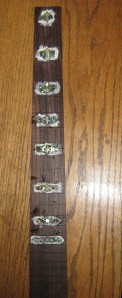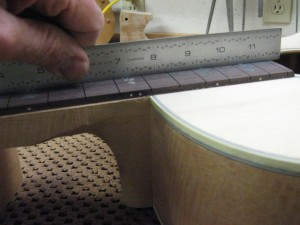Neck (Pt. 4)
The next part of the construction process is the fretboard. This guitar is being built with a 26.5″ scale length. The fret slots are very accurately sawn into the fretboard according to the scale length being used. Placement of the fret slots is determined by something I have seen referred to as the “rule of 18,” but it would be more accurate to call it the “rule of 17.835.” Here is how it works: to determine the distance of the first fret from the nut end of the fretboard, divide the scale length by 17.835. With this scale, that comes out to 1.49″, so that is where the first fret slot should be sawn. To determine the distance from the first fret to the second, you subtract 1.49″ from the original 26.5″ scale, then divide the remaining number by 17.835. The quotient this time is a little less than 1.49″ and it tells me where the second slot should be placed. This process of subtraction and division continues as you move up the fretboard until all of the slots are cut.
To say that this is a bit tedious is understating the situation. When I first was building guitars I would do the work of cutting the fret slots myself. It would take several hours to mark and cut all of the fret slots. Now, however, I purchase pre-slotted fretboards whenever I can. There are businesses that specialize in computer assisted slotting and they are much more accurate than I could ever hope to be with my ruler, carpenter’s square and backsaw. Accurate placement of the slots–down to 0.001″–is essential for the guitar to play in tune, so the cost of paying someone to do this job is well justified.
I forgot to take an earlier picture, but here is the slotted and tapered rosewood fretboard with the inlays glued in and not yet sanded level
After the epoxy dries on the inlays, I sand them level with the surface of the fretboard and glue the fretboard to the neck.
I then sand the fretboard so that it is perfectly flat against a straight edge before installing the frets.



